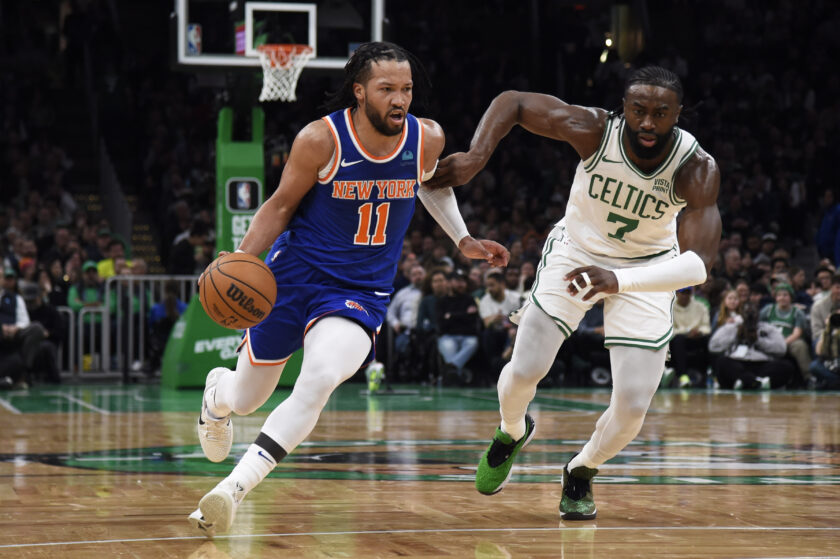New York Knicks: Drafting the all-1970s starting lineup

After the Swingin’ Sixties shifted to the 1970s, the New York Knicks finally looked like a dynasty in the new decade.
[sc name=”josh-benjamin-banner” ]Picture New York City in the 1970s.
It’s a weird time not just in the Big Apple, but throughout the country. Racial tensions still run high despite the progress birthed by the Civil Rights Movement. Trust in the system reaches an all-time low with Watergate. Checking in on the New York Yankees, the Bronx is literally burning.
Further south, in the Bay Ridge and Bensonhurst neighborhoods of Brooklyn, young men obsessively discuss Saturday Night Fever and dream of being Tony Manero.
The New York Knicks, meanwhile, are sitting pretty. As the NBA’s popularity grows, New York wins three Eastern Conference titles in four years along with two NBA championships. The long, hard rebuild of the 1960s finally pays off.
And looking back at the Knicks squads of the 1970s, they’re easy to root for. They had swagger. They had million-dollar smiles. These Knicks perfectly matched the sass of the decade even if their success petered out in its latter half.
That said, let’s turn the page to the next chapter of this series and draft the New York Knicks’ All-1970s Team.
PG: Walt “Clyde” Frazier (Knicks tenure: 1967-1977)

Younger Knicks fans like to goof on Walt “Clyde” Frazier for his loud suits and knack for rhymes as an MSG analyst. Still, the man is still so beloved in New York, and for good reason.
The New York Knicks made Frazier a first-round pick out of Southern Illinois in 1967, picking him at No. 7. After coming off the bench for a year, he became the starting point guard and absolutely skyrocketed.
Playing alongside the dominant Willis Reed, Frazier was an electrifying scoring point guard. To borrow his terminology, he made an art out of slashing and dashing his way to the rim to make his shot. In 10 Knicks seasons, Frazier averaged 19.3 points, 6.3 assists, 6.1 rebounds, and a pair of steals per game.
Frazier also shot 49.2% from the field as a Knick and led the league in win shares per 48 minutes (WS/48) in 1970. He was an even greater force in the playoffs, averaging 20.7 points while shooting 51.1%. In Game 7 of the 1970 NBA Finals, with Reed playing on one leg, Frazier led the way with 36 points and an eye-popping 19 assists as the Knicks rolled to victory.
Though the seven-time All-Star was traded to the Cleveland Cavaliers in 1977, his legacy will always be in New York.
SG: Earl Monroe (Knicks tenure: 1971-1980)

Earl “The Pearl” Monroe didn’t have much range with the ball, but came to the Knicks at the perfect time. Injuries were starting to catch up to Reed, so Frazier needed a new go-to guy.
All it took was trading reserves Mike Riordan and Dave Stallworth to the Baltimore Bullets in 1971, and Monroe was a Knick. Serving as more of a combo shooting guard while Frazier ran the point, Monroe excelled in a New York uniform. He averaged 16.2 points per game and shot 47.8% from the field in nine Knicks seasons, and also averaged more than 20 a game twice.
And even though Monroe was maybe just an above-average player from a numbers standpoint, he was still Robin to Frazier’s Batman. He was reliable even after his longtime teammate was traded and as he aged himself.
Monroe retired from the New York Knicks in 1980 and is still fondly remembered as a player by fans old and young. As we discuss the 1970s team, it’s only right he man the two while Frazier runs the point.
SF: Bill Bradley (Knicks tenure: 1967-1975)

Bill Bradley was unlike most professional athletes during his playing days. He was a Princeton graduate. After the Knicks made him a territorial selection in the 1965 NBA Draft, he took two years to go to Oxford as a Rhodes Scholar.
And when he came back to play professional basketball, Bradley did not dazzle nor was he a superstar. He never averaged more than 16.1 points per game. He wasn’t a strong defender either.
But regardless of what the numbers say, Bradley just played smart basketball. He stepped on the court, worked his position on the wing accordingly, and won two championships in the process before retiring at age 33.
For context, Bradley averaged 12.4 points and shot 44.8% for his career. Yet, he averaged 14.6 points per 36 minutes and his true shooting percentage (TS%) was 48.6. Given the talent around him, he was actually quite a reliable wing.
Oh, and did I mention he later served three terms in the Senate and ran for president in 2000?
PF: Dave DeBusschere (Knicks tenure: 1968-1974)

As the Knicks shifted from rebuilding to being a contender in the late 1960s, a better power forward was needed alongside Willis Reed. Popular center Walt Bellamy was subsequently dealt to the Detroit Pistons with point guard Howard Komives, and DeBusschere became a Knick.
Though only 6-foot-6 compared to the 6-foot-11 Bellamy, the Detroit native’s strong work ethic was just what the doctor ordered. DeBusschere spent the rest of his playing days in New York and was reliable as a power forward could be and then some. He averaged 16 points and 10.7 rebounds in six seasons and shot 43.9% from the field.
DeBusschere also posted a TS% of 47.3 in a Knicks uniform and was able to hold his own on defense. He wasn’t an elite scorer, but could still stretch the floor while also being a force in the paint.
And his good work for the Knicks didn’t stop at retirement. He also served as the team’s president of basketball operations in the 1980s, during which he drafted iconic center Patrick Ewing.
But that’s another story.
C: Bob McAdoo (Knicks tenure: 1976-1979)

Unlike everyone else listed here, Bob McAdoo did not spend a significant portion of his career with the New York Knicks. In fact, it can be argued his time in New York was over just as quickly as it began.
The Knicks acquired McAdoo in a trade with the Buffalo Braves in December 1976, and he made an immediate impact. The former Tar Heel averaged 26.7 points and 12.7 rebounds per game for the rest of the season. The following year, his only full one with the Knicks, he posted 26.5 points and 12.8 rebounds.
McAdoo was then traded to the Boston Celtics in 1979 and played seven more years. Along the way, he played for the Pistons, New Jersey Nets, Los Angeles Lakers, and Philadelphia 76ers.
But the fact remains that for the New York Knicks, McAdoo was still at his best. He averaged 26.7 points and 12 points wearing the orange and blue. His VORP in New York was 9.3, or a 25.1 WAR in baseball terms, in basically two years.
His time with the Knicks was short, but McAdoo made the most of this stop in his Hall of Fame career.
Josh Benjamin has been a staff writer at ESNY since 2018. He has had opinions about everything, especially the Yankees and Knicks. He co-hosts the “Bleacher Creatures” podcast and is always looking for new pieces of sports history to uncover, usually with a Yankee Tavern chicken parm sub in hand.





